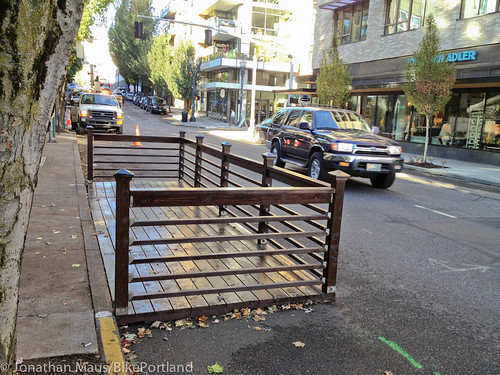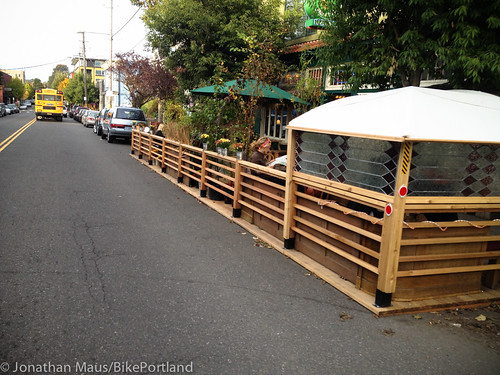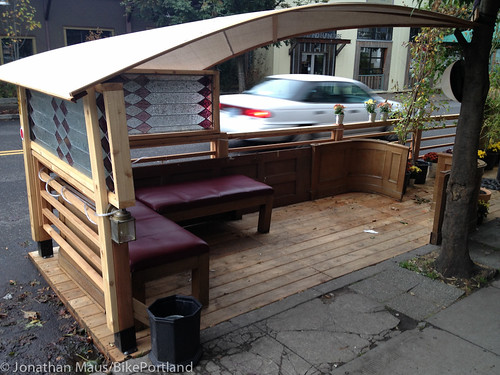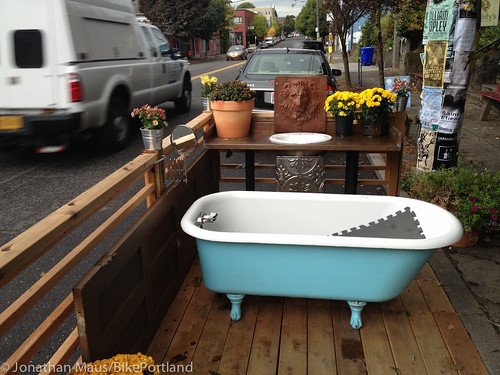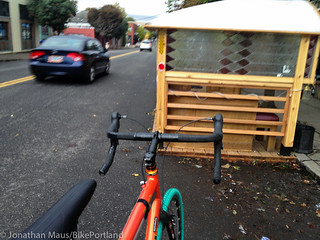
a future bikeway hard(er) to envision.
(Photos © J. Maus/BikePortland)
Two new ‘street seats’ installations have popped up around Portland recently. The City of Portland program allows cafe owners to pay for a permit (along with other fees) and then install a patio seating structure in the street. Instead of car parking, businesses get more human parking, expand their dining footprint, and (potentially) expand their revenue.
The other day I noticed one on NW Everett between 10th and 11th (outside Oven & Shaker pizza joint) and on N Mississippi north of Fremont (in front of Mississippi Pizza Pub).
The Oven & Shaker installation is pretty minimal at this point, with just the wooden structure and side railings.
But the Mississippi Pizza structure is the largest and most elaborate one of the three I’ve seen so far. It looks to be twice as long as the others and it’s fully decorated with a covered booth for seating, a giraffe sculpture, and for some reason, a bathtub and sink!
My first reaction to this program was excitement — I love how it reclaims public space for humans and away from toxic, loud, and dangerous vehicles. But seeing the large installation on Mississippi also brings up another thought: How is bike access impacted?
Narrow, two-lane commercial main streets like Mississippi, Alberta, NE/SE 28th, and so on, lack adequate bicycle access. Instead of the low-stress facilities we aim for, these streets are dominated by auto and bus traffic. Those who do ride bicycles on them are either strong and fearless enough to ride fast while taking the lane; or worse, they squeeze along the right side just inches between parked cars and moving vehicles. I have long held out hope that the on-street parking lane is the future location of a dedicated cycle-track or some other type of low-stress bikeway.
With ‘street seat’ patios now in the parking lane, will that make it even more difficult to consider using that space as a bikeway in the future? It has taken decades to pry auto parking out of the hands of business owners. Now the City has managed to do it by giving them more seating space. (The same can be said for on-street bike corrals, but those are less “owned” by the businesses and therefore seem like they would be easier to move for a future bikeway.)
Will these business owners want to uproot their nice patio seating for a bikeway someday? Or, perhaps this isn’t the end of the bikeway discussion but the beginning of the carfree street discussion?
Reader Michael Berg emailed me this morning with some good insight. He said the type of space reclamation being hastened by this patio parking is how Copenhagen started what he calls their “walking streets.”
“Cafes kept creeping out further and further in the street, making it more and more difficult to drive,” he wrote. “Eventually people stopped driving the streets because it was a PITA [pain in the ass] and nobody complained when cars were removed completely. It really is a brilliant way to go about it because it happens so naturally.” (All deliveries would be done before 10:00 am, he said, and then it’s humans only.)
That’s an exciting idea to consider. For now though, we’ve got these permanent structures taking up space in an extremely limited right of way. It’s important to note that, according to the permit language, PBOT says they’ll issue 15 permits during this “pilot” phase, which ends on December 31st. After that date, the structures must be removed — unless of course the program is renewed.
What do you think?


